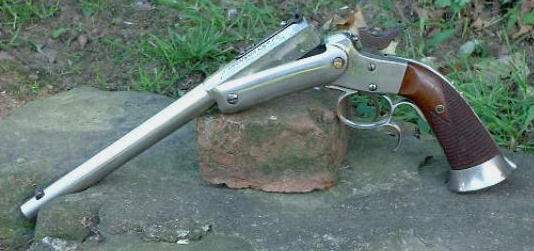

 The Accurate Reloading Forums
The Accurate Reloading Forums  THE ACCURATE RELOADING.COM FORUMS
THE ACCURATE RELOADING.COM FORUMS  Guns, Politics, Gunsmithing & Reloading
Guns, Politics, Gunsmithing & Reloading  Single Shot Pistols
Single Shot Pistols  Barrel Twist Rates?
Barrel Twist Rates?Go  | New  | Find  | Notify  | Tools  | Reply  |  |
one of us |
I have always believed that the Green Hill formula provides the "minimum" twist rate and that slightly faster twists could increase accuracy as a general rule. Does anyone have any information to prove or disprove this?? | ||
|
one of us |
Mike Don Shearer uses that formula quite a bit when he is figuring out twist rates for different caliber projects. If he sees this I'm sure he will jump in. I believe he has a good understanding of how the formula works. Rich Jake | |||
|
| one of us |
MSS, As Rich says, I have used the Greenhill formula quite a bit. My experience is mostly with the 22, 25, 30 and 35 calibers. What I see, across the board, is that the Greenhill formula is quite useful, but don't use it without some tempering. Remember it was developed at turn-of-the-century -1900- and was applied to bullet stability when a bullet was a hunk of solid lead with a much different balance point and flight characteristics than we see today. It is useful in determining "about" the right twist rate, and is best for jacketed, lead-tipped bullets. Where you start having trouble is with the Hollow Point and plastic-tipped bullets because of their different center of balance and different mass/length. I just went through the question of twist as I was ordering a 17 caliber Contender barrel. During the course of that investigation, I talked to the people at Shilen and Hornady. They both said that especially for the 17 caliber, the Greenhill should be used only as a guide or as a first step. But remember, at turn-of-the-century was there even a 17 caliber? I don't think so as at that time a small caliber was .30 Of course there were the 22's but did anyone worry about stability of a 22? What I have seen in using the Greenhill, is that for the lower velocities <2800 f/s, using the constant of 150 is OK and for the higher velocities >2800 f/s a constant of 180 is better. I have further found that for the 22 center fires above 3000 f/s a constant as high as 190 is even better, for the 30 caliber's above about 2500 f/s a constant of 180 is better, and for the 35 caliber's at 2000 f/s 150 is OK. And yes, to actually have a twist a little faster than is shown by the Greenhill is likely to serve a little better, but we need to be a careful as to overstabilize too much can work against us as well. The reason for this is that a properly stabilized bullet will fly to be oriented on the axis of the trajectory while an over stabilized bullet will fly oriented on the axis of the barrel. This means at the longer ranges when the trajectory is curving downward, the overstabilized bullet will still be pointed on the axis of the barrel and will be flying partially sideways in a slightly nose-up position with respect to the trajectory. And so, I guess my answer to the question is to recommend being a bit cautious. Don Shearer | |||
|
| one of us |
An interesting description talking about gyroscopic stability... "...The actual formula is much more complicated It is Gyroscopic Stability (GS) = the spin rate (in radians per second, squared) times the polar moment of inertia, squared, divided by the pitching moment coefficient derivative per sine of the angle of attack times the transverse moment of inertia times the air density times the velocity squared. (My keyboard does not have all the correct symbols and that is why I wrote it out). For the bullet to be stable, GS > 1.0. This is actually a short version as the pitching moment coefficient component is a complicated calculation that derives the center of gravity and the center of reverse air pressure. The equation is basically calculating the linear difference between the center of gravity and the center of reverse air pressure on the nose of the bullet. The greater the difference, the greater the spin required to keep the bullet pointed nose forward. It used to take me about three days to calculate one new design by hand. My computer does it in about 20 seconds, now." I can't find the webpage at the moment, but I have posted a reference to a site previously in this forum regarding the mathematics behind this calculation. It is possible that it can be dug up with a search... | |||
|
| Powered by Social Strata |
| Please Wait. Your request is being processed... |
|

Visit our on-line store for AR Memorabilia

